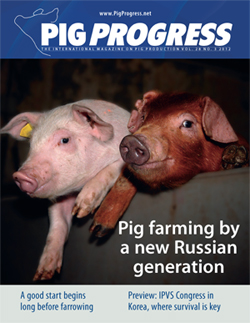MAGAZINE: A Russian farm, potato peptides, focus on iron

A glimpse inside a Russian farm, how fermented potatoes can benefit piglets and an overview of uses of iron are just some of the ingredients of this year’s third issue of Pig Progress, containing 44 pages.
For whomever is interested in the former Soviet Union, this issue of Pig Progress brings some good news. A 2.5 page article takes our readers to Ukraine, and discusses opportunities for pig production in this vast country. Experts believe its best years are yet to come.
Pig Progress also had a look inside the ‘Selectiono-Gybridnii Centr’, at 200 km away from Voronezh, in Russia. The farrow-to-finish farm currently has 3,000 sows. Despite the risk African Swine Fever poses in Russia, there are strong expansion plans to grow in the next couple of years to 15,000 sows.
Previews
Another region that faced disease related setbacks is South Korea, as Foot-and-Mouth Disease severely reduced the country’s breeding herd in late 2010. Still, in June, the country will be the proud host of the 22nd International Pig Veterinary Society Congress. Time for a preview!
Another region that faced disease related setbacks is South Korea, as Foot-and-Mouth Disease severely reduced the country’s breeding herd in late 2010. Still, in June, the country will be the proud host of the 22nd International Pig Veterinary Society Congress. Time for a preview!
The magazine also had a sneak preview in Iowa, where the World Pork Expo will take place (6-8 June), only days prior to the IPVS Congress. Several topics will be top of mind there – what to think of antibiotics or feed prices? With rising manure demand, however, there are also opportunities for pork producers – Kelvin Leibold, Iowa State University explains.
Iron
Iron plays an important role in this issue, and several ways of supplementation receive a closer look. What to think about iron injection? Professor Jens Peter Nielsen, University of Copenhagen, explains the role of iron as a health and growth benefactor.
Iron plays an important role in this issue, and several ways of supplementation receive a closer look. What to think about iron injection? Professor Jens Peter Nielsen, University of Copenhagen, explains the role of iron as a health and growth benefactor.
Iron can also be administered orally to piglets. This has its own set of advantages, explains Tim Hesselballe Hansen, at Biofiber Damino. He dives into the iron absorption mechanism in piglets and explains the role of hepcidin.
Nutrition
Apart from the oral iron administration, several articles are related to nutrition. Huvepharma’s Dennis Smulders is introducing a novel approach to piglet growth using fermented potato proteins.
Apart from the oral iron administration, several articles are related to nutrition. Huvepharma’s Dennis Smulders is introducing a novel approach to piglet growth using fermented potato proteins.
Blood plasma is known to be a good source of proteins for weanling pigs. What is known about its mode of action is often referred to as being very tasty as well as containing immunoglobulins. But is this all? In a recent webinar, aimed at replacement of antibiotics, two scientists from APC Europe zoomed in on this question.
Dr Bill Close and Dr Jules Taylor-Pickard explain readers in this issue how trace minerals can help achieve 35 piglets per sow per year – both by enhancing sow lifetime performance and by increasing piglet weaning weight.
Dr Ioannis Mavromichalis, a regular contributor to Pig Progress, is strongly present having three very valuable pieces of information. He zooms in on less known protein sources for pigs, think of maize gluten, sunflower seeds, minor legumes and rapeseed.
In ‘Feeding piglets better’, Dr Mavromichalis also presents an eight-step what-to-do checklist by which each pork producers help getting all piglets through weaning.
In his monthly Nutrition FAQ section, he zooms in on the theme of nutrients.
Rats and flies
Another regular contributor, John Gadd, spends attention to unwanted creatures in the pig house – rats and flies. They can easily be overlooked in a biosecurity plan – it’s good to be aware of this.
Another regular contributor, John Gadd, spends attention to unwanted creatures in the pig house – rats and flies. They can easily be overlooked in a biosecurity plan – it’s good to be aware of this.
Definitely one of the most interesting contributions in PP 28.03 is written by Laurent Roger, from French company CCPA. He touches on the phenomenon of intra-uterine growth retardation (IUGR) – and whether feeding could potentially affect this phenomenon.
The monthly section ‘Company Focus’ took a look in the novel Gene Transfer Centre of pig breeder PIC, which opened its doors in the UK earlier this year.
The last word this issue, in ‘Expert Talk’, is Dr Hugo Seemer, Boehringer Ingelheim, discusses the necessity for the livestock industry to act now antibiotics are increasingly disappearing from the scene. It is time for other approaches, like e.g. better management, biosecurity and vaccinations.











